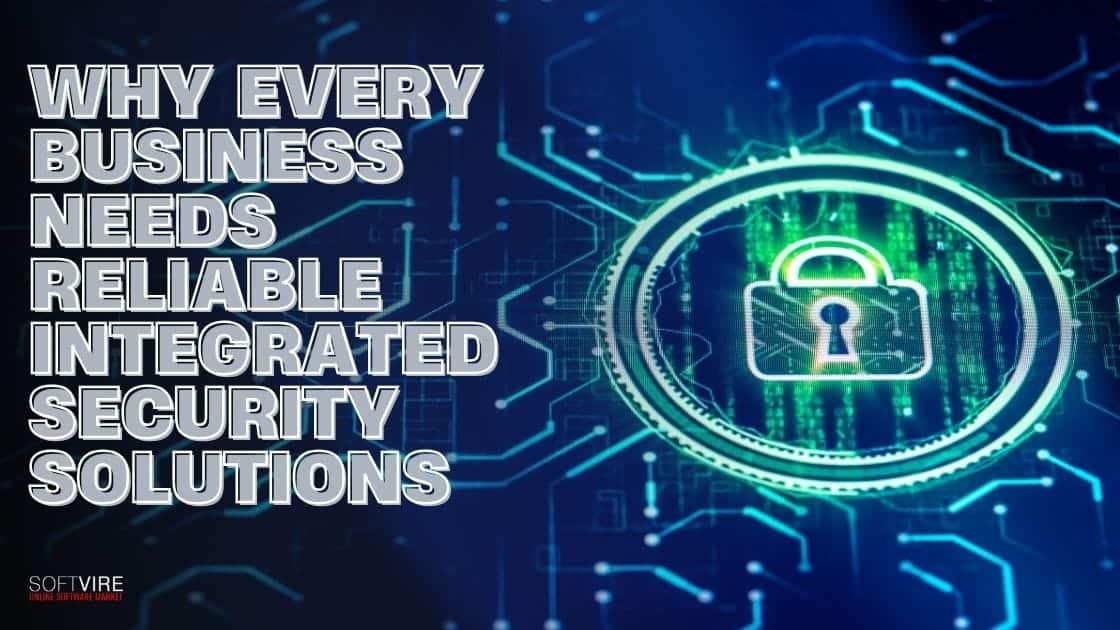Security risks to enterprises consistently advance, underscoring the need for a robust security plan.
Businesses encounter several dangers, including burglary, unauthorized entry, fire hazards, and vandalism, which may interrupt operations and result in financial losses.
Businesses are vulnerable to theft, damage, and non-compliance with industry regulations without the proper security measures.
In this guide, we’ll explore why integrated security solutiions are essential for modern businesses, how it works, and how it helps improve safety, efficiency, and compliance.
What Are Integrated Security Solutions?
Integrated security solutions are comprehensive systems that amalgamate several security layers—both physical and digital—into a unified framework. Rather than depending on disparate technologies that may lack interoperability, integrated solutions function cohesively to safeguard all facets of your enterprise.
The effectiveness of an integrated security system depends on its ability to automate and integrate different security components. Each component talks to the others, ensuring a synchronized security response instead of each working separately.
So, how does it work?
Intruder alarms trigger CCTV cameras to record the area in real time for security. If unauthorized access is detected, the system may lock doors, notify security, and trigger alarms at limited entrance points.
The system may open exits, sound alarms, and summon 911 in a fire. Automatic replies improve enterprise incident management, reaction times, and security layers.
Why Integration Matters?
Improved Incident Response
A security breach requires quick action. The less harm a danger will inflict, the sooner you can find, isolate, and eliminate it. A connected system assists by connecting the dots. If one component of your system identifies something odd, it may automatically notify other components and start a coordinated reaction.
Reduced Human Error
When departments function separately, crucial messages might be missed. A security camera may detect suspicious activity, but no action will be taken if no one in IT notices it. Integration helps fill these gaps by assuring that every team works from the same source of truth.
Cost-Efficiency
Integration may have greater initial expenditures, but it saves much money in the long run—system streamlining results in efficiency gains in security management, fewer maintenance requirements, and less duplication. You also avoid the monetary fallout resulting from security breaches, such as lost data, legal fees, and damaged reputation.
Compliance and Reporting
HIPAA, GDPR, PCI DSS, and other regulations apply to many sectors. Integrated systems make compliance easier by centralizing reporting, documentation, and tracking. Audits become less of a headache when all security data is readily available in one location.
Scalability
As your business grows, so do your security needs. Integrated solutions are designed to scale. Whether you open a new office, hire remote workers, or migrate services to the cloud, a well-integrated system can adapt without starting from scratch.
Key Components of an Integrated Security System
A successful integrated security system combines many aspects of digital protection, communication tools, physical security, and operational procedures into a smooth and collaborative framework.
Here is a closer examination of the primary elements that comprise this system:
Cybersecurity Tools
In our increasingly digital business environment, cybersecurity is the backbone of any security system. These tools protect against unauthorized access, data breaches, malware, and other forms of cyberattacks.
- Firewalls and Intrusion Prevention Systems (IPS)
- Antivirus and Endpoint Protection
- Data Encryption and DLP (Data Loss Prevention)
- Identity and Access Management (IAM)
- Security Information and Event Management (SIEM)
Physical Security Systems
Physical security is still crucial, even if digital dangers get all the attention. Theft, trespassing, and sabotage can’t harm your property or possessions without integrated physical protection.
- Access Control Systems
- Video Surveillance (CCTV)
- Intrusion Detection and Alarm Systems
- Visitor Management Systems
Communication and Monitoring Platforms
For an integrated system to function properly, centralized communication and monitoring capabilities must tie all components together.
- Centralized Dashboards
- Mobile Access and Alerts
- Incident Management Systems
- Cloud Integration
Operational Policies and Procedures
Technology alone isn’t enough. Integrated security also depends on strong policies, processes, and human oversight.
- Incident Response Plans
- Security Awareness Training
- Regular Audits and Assessments
- Compliance Management
- Change Control and Maintenance Procedures
Artificial Intelligence and Analytics (Advanced Component)
Modern integrated security systems are beginning to harness the power of AI and machine learning for predictive capabilities.
- Behavioral Analytics
- Predictive Maintenance
- Threat Intelligence Integration
Why Businesses Need Integrated Security?
Enhanced Threat Detection and Response
In a security breach, immediate response is required; however, this can only be accomplished with a system intended to detect and respond in real time.
An integrated security system guarantees that the various security components collaborate to offer rapid warnings and automatic reactions, lowering the risk and minimizing harm.
For instance, an integrated system can turn on CCTV cameras to start recording and provide security staff with live feed if an intruder alert is set off.
To prevent further intrusion, lock or limit access to certain places and instantly notify emergency responders, company owners, and security personnel.
This automated reaction lowers the likelihood of escalation by ensuring that threats are addressed promptly and efficiently. It also gives security professionals situational knowledge in real-time.
Enhanced Operational Efficiency
Multiple security systems may be difficult to manage independently, which can be time-consuming and wasteful. Everything is centralized inside an integrated security system, which enables organizations to monitor and manage security measures from a single platform.
Businesses can reduce complexity by monitoring multiple security elements from a single interface, which is facilitated by integration.
You can control security systems remotely from a mobile device or computer, including securing doors, monitoring live CCTV feeds, and activating alarms.
Minimize human intervention by automating repetitive security tasks, such as periodic access permissions and alarm configurations.
As they integrate their security processes, companies can save time, reduce the possibility of human errors, and improve their overall security effectiveness.
Promoting a Safe Working Environment
Every company must provide a secure workplace for its workers. Physical security measures like gates and barriers deter crime by preventing unauthorized people from accessing your building. An access control system can also monitor who is on your property and determine how many people should be evacuated in an emergency.
By integrating these features, your organization communicates to employees that it prioritizes safety. Creating a safety culture will ensure that good talent is kept, thus helping your business continuously grow.
Protect Your Valuable Assets
Integrating technological and physical security is an efficient method of picking up theft and vandalism and tracking any activity that might occur. Your precious assets, whether unique items, sensitive data, or costly equipment, result from your hard work. Protecting your hard-earned possessions requires a well-planned security strategy incorporating intrusion detection and video monitoring methods.
Secure Cash Flow and Save Money
Insurance typically only covers depreciated replacement costs if your assets are stolen or vandalized. This coverage does not account for delays or lost retail profits, so preventing crime is a potent method of protecting your cash flow.
Internal and external security may inhibit workers’ unethical activity. Employee theft and embezzlement may cost more than outside burglary. The same security culture that retains great staff may reduce internal theft.
A properly integrated security system may also save insurance costs. Commercial security systems may get insurance incentives. Call your insurance agent to verify eligibility.
The Future of Integrated Security: Technology Trends
Technology advances are transforming the integrated security field, broadening our capabilities in exciting new ways. These physical and electronic security trends are critical for defending any business as technology evolves.
Harnessing artificial intelligence’s potential, migrating data to the cloud, and upgrading video surveillance technology will be key topics in future years. Stay ahead of these changes to protect your facilities, data, and staff.
Artificial Intelligence
A more intelligent security system will make your building safer. Full-service security integrators are increasingly using artificial intelligence security systems to improve the functionality of alarm and video monitoring systems. Features like enhanced motion detection and behavior analysis show how AI might assist systems in better identifying dangers.
With the continued development of machine learning, AI security systems will soon be capable of sifting through mountains of risk data and producing tailored reports on potential dangers.
Ultimately, these elements will aid organizations in making connections between industry-wide dangers and their local environments.
Cloud-Based Security
Cloud storage and operation services are rising across various industries, including video surveillance and complete data networks. With cloud services, you won’t have to spend money on expensive local servers and specialized software. Also, they offer more flexibility to companies with telecommuters or global teams.
Cloud-based security solutions seamlessly combine data networks, storage capacity, and management systems with electronic security controls. They also offer analytical capabilities that provide companies with easy access to important updates, market trends, and security alerts.
Biometrics
Many smartphone manufacturers now include biometric features, such as fingerprint and face recognition, in their products. These innovations are also used in contemporary security systems, such as access control systems that accept mobile devices as login credentials.
Cybersecurity, intrusion detection, and access control are three areas that stand to benefit significantly from more advanced methods of protecting this crucial biometric data.
Multi-Dimensional Perception
Even though security camera video quality has increased dramatically in recent years, factors other than visual imaging are increasingly becoming relevant. Developments in sensing technology and clever algorithms have made the integration of many sensor types into a single system feasible.
These sensors may detect radar signals, temperature and humidity variations, gas pressure, and even UV radiation. Adding more dimensions allows video systems to be used for various security requirements.
Cameras with High-Definition Powered by 5G
Visibility is essential for security in every environment. Thanks to ultra-high-definition cameras, crisp photos may be captured even amid harsh weather conditions, such as dense fog or heavy rain. Some versions have thermal imaging and low-light capabilities to take security to the next level.
The advent of 5G connections has been a lifesaver for transmitting massive HD video files. Thanks to 5G networks, which are far quicker and have more capacity than 4G, we can now transmit much more data at better quality and speed. When the dependable transmission of huge, apparent video data becomes a reality, we may be about to see a wireless video security revolution.
Final Thoughts
No company is invulnerable to security threats. The repercussions can be dire, whether a phishing attack, an insider threat, or a failure in security cameras. That’s why integrated security solutions are a must—not only as a defense system but as a strategic investment.
Integration enables your business to be proactive rather than reactive. It brings people, processes, and technology together under one cohesive strategy for managing risk. Having confidence that your business is protected, resilient, and prepared for whatever lies ahead brings a sense of peace.
So, whether you’re just starting your security journey or looking to upgrade your current systems, now is the time to consider integration. It’s not about adding more tools—it’s about making the tools you already have work better together.
Want to discuss further about integrated security solutions? Meet us on Facebook, X (Twitter), or LinkedIn.
About Author: Jennysis Lajom has been a content writer for years. Her passion for digital marketing led her to a career in content writing, graphic design, editing, and social media marketing. She is also one of the resident SEO writers from Softvire, a leading IT distributor.



The Intent Economy: How Behavioral Marketing Has Redefined Advertising Tactics
Unlock High-Converting Google Ads with Smarter AI Prompts